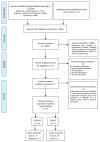Validity of Pneumonia Severity Assessment Scores in Africa and South Asia: A Systematic Review and Meta-Analysis
- PMID: 34574976
- PMCID: PMC8467534
- DOI: 10.3390/healthcare9091202
Validity of Pneumonia Severity Assessment Scores in Africa and South Asia: A Systematic Review and Meta-Analysis
Abstract
Background: Although community-acquired pneumonia (CAP) severity assessment scores are widely used, their validity in low- and middle-income countries (LMICs) is not well defined. We aimed to investigate the validity and performance of the existing scores among adults in LMICs (Africa and South Asia).
Methods: Medline, Embase, Cochrane Central Register of Controlled Trials, Scopus and Web of Science were searched to 21 May 2020. Studies evaluating a pneumonia severity score/tool among adults in these countries were included. A bivariate random-effects meta-analysis was performed to examine the scores' performance in predicting mortality.
Results: Of 9900 records, 11 studies were eligible, covering 12 tools. Only CURB-65 (Confusion, Urea, Respiratory Rate, Blood Pressure, Age ≥ 65 years) and CRB-65 (Confusion, Respiratory Rate, Blood Pressure, Age ≥ 65 years) were included in the meta-analysis. Both scores were effective in predicting mortality risk. Performance characteristics (with 95% Confidence Interval (CI)) at high (CURB-65 ≥ 3, CRB-65 ≥ 3) and intermediate-risk (CURB-65 ≥ 2, CRB-65 ≥ 1) cut-offs were as follows: pooled sensitivity, for CURB-65, 0.70 (95% CI = 0.25-0.94) and 0.96 (95% CI = 0.49-1.00), and for CRB-65, 0.09 (95% CI = 0.01-0.48) and 0.93 (95% CI = 0.50-0.99); pooled specificity, for CURB-65, 0.90 (95% CI = 0.73-0.96) and 0.64 (95% CI = 0.45-0.79), and for CRB-65, 0.99 (95% CI = 0.95-1.00) and 0.43 (95% CI = 0.24-0.64).
Conclusions: CURB-65 and CRB-65 appear to be valid for predicting mortality in LMICs. CRB-65 may be employed where urea levels are unavailable. There is a lack of robust evidence regarding other scores, including the Pneumonia Severity Index (PSI).
Keywords: community-acquired pneumonia; developing countries; meta-analysis; mortality; prognosis; severity of illness index; systematic review.
Conflict of interest statement
The authors declare no conflict of interest.
Figures





Similar articles
-
External validation of the CURSI criteria (confusion, urea, respiratory rate and shock index) in adults hospitalised for community-acquired pneumonia.BMC Infect Dis. 2014 Jan 22;14:39. doi: 10.1186/1471-2334-14-39. BMC Infect Dis. 2014. PMID: 24447823 Free PMC article.
-
Short-term mortality of adult inpatients with community-acquired pneumonia: external validation of a modified CURB-65 score.Postgrad Med J. 2015 Feb;91(1072):77-82. doi: 10.1136/postgradmedj-2014-132802. Epub 2015 Jan 24. Postgrad Med J. 2015. PMID: 25618316
-
Role of Semi-quantitative Serum Procalcitonin in Assessing Prognosis of Community Acquired Bacterial Pneumonia Compared to PORT PSI, CURB-65 and CRB-65.J Clin Diagn Res. 2015 Jul;9(7):OC01-4. doi: 10.7860/JCDR/2015/12468.6147. Epub 2015 Jul 1. J Clin Diagn Res. 2015. PMID: 26393153 Free PMC article.
-
The Battle of the Pneumonia Predictors: A Comprehensive Meta-Analysis Comparing the Pneumonia Severity Index (PSI) and the CURB-65 Score in Predicting Mortality and the Need for ICU Support.Cureus. 2023 Jul 29;15(7):e42672. doi: 10.7759/cureus.42672. eCollection 2023 Jul. Cureus. 2023. PMID: 37649936 Free PMC article. Review.
-
Utility of pneumonia severity assessment tools for mortality prediction in healthcare-associated pneumonia: a systematic review and meta-analysis.Sci Rep. 2024 Jun 5;14(1):12964. doi: 10.1038/s41598-024-63618-3. Sci Rep. 2024. PMID: 38839837 Free PMC article.
Cited by
-
The National Early Warning Score 2(NEWS2) to Predict Early Progression to Severe Community-Acquired Pneumonia.Trop Med Infect Dis. 2023 Jan 17;8(2):68. doi: 10.3390/tropicalmed8020068. Trop Med Infect Dis. 2023. PMID: 36828485 Free PMC article.
-
Pneumonia-specific plasma metabolite profiles among patients hospitalised with infection in Southeast Asia.ERJ Open Res. 2025 May 27;11(3):00582-2024. doi: 10.1183/23120541.00582-2024. eCollection 2025 May. ERJ Open Res. 2025. PMID: 40432817 Free PMC article.
-
Risk factors and predicting nomogram for the clinical deterioration of non-severe community-acquired pneumonia.BMC Pulm Med. 2024 Jan 27;24(1):57. doi: 10.1186/s12890-023-02813-w. BMC Pulm Med. 2024. PMID: 38280994 Free PMC article. Clinical Trial.
-
A Service Evaluation of Adherence with Antimicrobial Guidelines in the Treatment of Community-Acquired Pneumonia Before and During the SARS-CoV-2 Outbreak.SN Compr Clin Med. 2022;4(1):225. doi: 10.1007/s42399-022-01311-0. Epub 2022 Oct 13. SN Compr Clin Med. 2022. PMID: 36258797 Free PMC article.
-
Comparison of Different Scoring Systems for Prediction of Mortality and ICU Admission in Elderly CAP Population.Clin Interv Aging. 2021 Oct 28;16:1917-1929. doi: 10.2147/CIA.S335315. eCollection 2021. Clin Interv Aging. 2021. PMID: 34737556 Free PMC article.
References
-
- Troeger C., Forouzanfar M., Rao P.C., Khalil I., Brown A., Swartz S., Fullman N., Mosser J., Thompson R.L., Reiner R.C., et al. Estimates of the global, regional, and national morbidity, mortality, and aetiologies of lower respiratory tract infections in 195 countries: A systematic analysis for the Global Burden of Disease Study 2015. Lancet Infect. Dis. 2017;17:1133–1161. doi: 10.1016/S1473-3099(17)30396-1. - DOI - PMC - PubMed
-
- Troeger C., Blacker B., Khalil I.A., Rao P.C., Cao J., Zimsen S.R.M., Albertson S.B., Deshpande A., Farag T., Abebe Z., et al. Estimates of the global, regional, and national morbidity, mortality, and aetiologies of lower respiratory infections in 195 countries, 1990–2016: A systematic analysis for the Global Burden of Disease Study 2016. Lancet Infect. Dis. 2018;18:1191–1210. doi: 10.1016/S1473-3099(18)30310-4. - DOI - PMC - PubMed
-
- Vos T., Allen C., Arora M., Barber R.M., Bhutta Z.A., Brown A., Carter A., Casey D.C., Charlson F.J., Chen A.Z., et al. Global, regional, and national incidence, prevalence, and years lived with disability for 354 Diseases and Injuries for 195 countries and territories, 1990–2017: A systematic analysis for the Global Burden of Disease Study 2017. Lancet. 2018;392:1789–1858. - PMC - PubMed
Publication types
LinkOut - more resources
Full Text Sources
Miscellaneous

